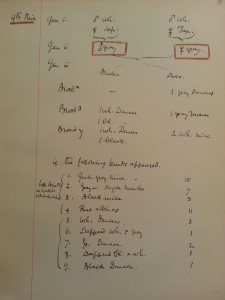 As today is Remembrance Day, it seems a fitting time to commemorate an early geneticist whose achievements were cut short by war. Arthur Dukinfield Darbishire (1879-1915) was appointed to the Lectureship in Genetics at the University of Edinburgh (the first of its kind in Britain). Had he lived, it is likely that Darbishire would have been offered the post of director of the newly formed Animal Breeding Research Station (later known as the Institute of Animal Genetics) in Edinburgh; the position that in 1921 was filled by F.A.E Crew.
As today is Remembrance Day, it seems a fitting time to commemorate an early geneticist whose achievements were cut short by war. Arthur Dukinfield Darbishire (1879-1915) was appointed to the Lectureship in Genetics at the University of Edinburgh (the first of its kind in Britain). Had he lived, it is likely that Darbishire would have been offered the post of director of the newly formed Animal Breeding Research Station (later known as the Institute of Animal Genetics) in Edinburgh; the position that in 1921 was filled by F.A.E Crew.
Darbishire was educated at Balliol College, Oxford, where he studied zoology. He soon became absorbed in problems of heredity and in the first few years of the twentieth century he began a series of breeding experiments with mice (known informally as the ‘waltzing mice’ experiments). At this point, his interests lay in the biometric rather than a Mendelian approach to heredity (ie that heredity relies on continuous rather than discontinuous variation), but when he became Demonstrator in Zoology at the University of Manchester in 1902, he began to reassess the Mendelian approach. He continued his experiments with mice in the light of his earlier biometric position, and concluded that the supposed contradiction between the two theories was due more to differences of opinion rather than inherent theoretical incompatibilities. He therefore cut himself adrift from both schools of thought, maintaining an independent and critical distance.
After a spell as Senior Demonstrator and Lecturer in Zoology at the Royal College of Science, in 1911 Darbishire accepted the newly created post of Lecturer in Genetics at Edinburgh, where he had the run of the University’s Experimental Farm at Fairslacks for breeding experiments. By 1914, Darbishire was delivering lectures at the University of Missouri, Columbia and was so successful that he was offered professorships from two American universities. However, Darbishire could not leave England after the outbreak of war. Upon returning, he was pronounced unfit for the Army (due to ‘physical delicacy’) but in July 1915 he tried a second time at a recruiting office, where he was accepted and enrolled as a private in the 14th Argyll and Sutherland Highlanders. His sister Helen wrote that ‘[h]e devoted himself to his duties as a soldier with the same zest and the same meticulous attention to detail that marked his work in other spheres, and he won the love and admiration of his comrades.’ However, within less than six months, Darbishire contracted cerebral meningitis whilst in military camp at Gailes. He died on Christmas Day 1915. Three days after his death, he was gazetted Second Lieutenant in the Royal Garrison Artillery.

Page from Notebook of Arthur Darbishire (c.1902), Edinburgh University Library Special Collections, EUA 1N1/ACU/A1/3/6
By the time that a young medic with an interest in animal breeding returned to Edinburgh after the war, he found that his two mentors at the University, Darbishire and F.H.A Marshall, were no longer there (Marshall had accepted a post in Cambridge). These two absences meant that, when it came to appointing a director of the new Animal Breeding Research Station, F.A.E Crew was ‘on the spot’ and duly appointed to the post in 1921. As we have seen, Crew made a great success of the Institute, but one wonders what differences Darbishire might have made to the development of genetics in Edinburgh. As it is, there is little concerning Darbishire in the archival and printed collections of ‘Towards Dolly’, although we do have one of his research notebooks and some of his collected offprints.
Helen Darbishire, who was later Principal of Somerville College Oxford, wrote of her brother in 1916:
All who knew him will keep in memory a personality alive and young to a rare degree, fulfilling itself in a passion for music, much laughter, a perfectly disinterested love of truth, a delight in producing delight in others, and the keenest possible interest in life itself whichever way it led him.
Reference:
Helen Darbishire, Preface to An Introduction to Biology and other papers by A.D Darbishire (Cassell and Company Ltd, 1917)

I have just catalogued a set of 6 recently acquired Darbishire offprints to be held in CRC: you may wish to check the dates in the header for this article.
Thanks John. You’re quite right – the header should say 1915 (as in the text!) rather than 1916. I will amend. Elizabeth showed me the Darbishire offprints the other day – glad we managed to acquire them! Clare